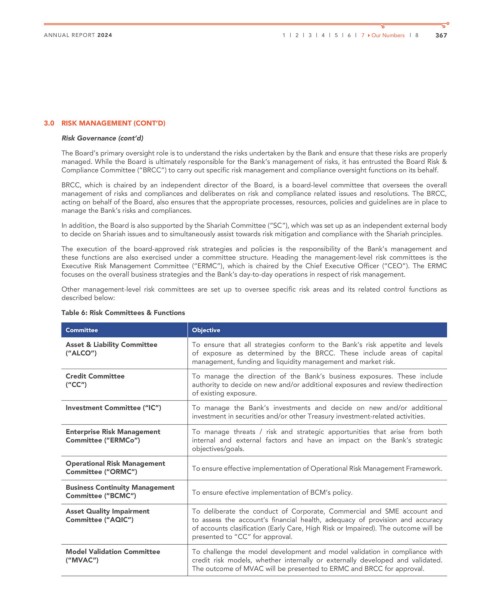Page 369 - Bank Muamalat_AR24
P. 369
ANNUAL REPORT 2024 1 2 3 4 5 6 7 Our Numbers 8 367
3.0 RISK MANAGEMENT (CONT’D)
Risk Governance (cont’d)
The Board’s primary oversight role is to understand the risks undertaken by the Bank and ensure that these risks are properly
managed. While the Board is ultimately responsible for the Bank’s management of risks, it has entrusted the Board Risk &
Compliance Committee (“BRCC”) to carry out specific risk management and compliance oversight functions on its behalf.
BRCC, which is chaired by an independent director of the Board, is a board-level committee that oversees the overall
management of risks and compliances and deliberates on risk and compliance related issues and resolutions. The BRCC,
acting on behalf of the Board, also ensures that the appropriate processes, resources, policies and guidelines are in place to
manage the Bank’s risks and compliances.
In addition, the Board is also supported by the Shariah Committee (“SC”), which was set up as an independent external body
to decide on Shariah issues and to simultaneously assist towards risk mitigation and compliance with the Shariah principles.
The execution of the board-approved risk strategies and policies is the responsibility of the Bank’s management and
these functions are also exercised under a committee structure. Heading the management-level risk committees is the
Executive Risk Management Committee (“ERMC”), which is chaired by the Chief Executive Officer (“CEO”). The ERMC
focuses on the overall business strategies and the Bank’s day-to-day operations in respect of risk management.
Other management-level risk committees are set up to oversee specific risk areas and its related control functions as
described below:
Table 6: Risk Committees & Functions
Committee Objective
Asset & Liability Committee To ensure that all strategies conform to the Bank’s risk appetite and levels
(“ALCO”) of exposure as determined by the BRCC. These include areas of capital
management, funding and liquidity management and market risk.
Credit Committee To manage the direction of the Bank’s business exposures. These include
(“CC”) authority to decide on new and/or additional exposures and review thedirection
of existing exposure.
Investment Committee (“IC”) To manage the Bank’s investments and decide on new and/or additional
investment in securities and/or other Treasury investment-related activities.
Enterprise Risk Management To manage threats / risk and strategic apportunities that arise from both
Committee (“ERMCo”) internal and external factors and have an impact on the Bank’s strategic
objectives/goals.
Operational Risk Management
Committee (“ORMC”) To ensure effective implementation of Operational Risk Management Framework.
Business Continuity Management
Committee (“BCMC”) To ensure efective implementation of BCM’s policy.
Asset Quality Impairment To deliberate the conduct of Corporate, Commercial and SME account and
Committee (“AQIC”) to assess the account’s financial health, adequacy of provision and accuracy
of accounts clasification (Early Care, High Risk or Impaired). The outcome will be
presented to “CC” for approval.
Model Validation Committee To challenge the model development and model validation in compliance with
(“MVAC”) credit risk models, whether internally or externally developed and validated.
The outcome of MVAC will be presented to ERMC and BRCC for approval.

